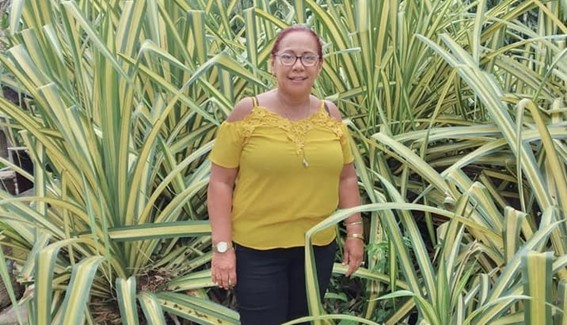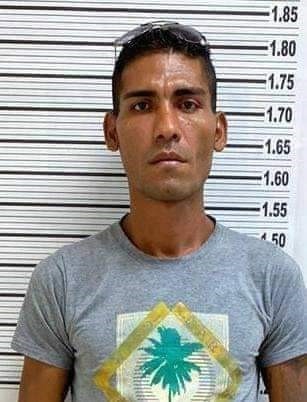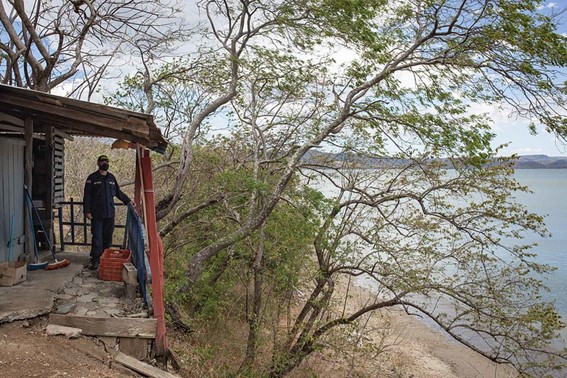Murder on the Border: Risks Nicaraguan Migrants Face

Norma left Nicaragua to work and build her house. She was killed along one of the unmarked crossing points, where increasingly dangerous criminal networks lurk.
By Cindy Regidor (Confidencial)
HAVANA TIMES – When Marbelly Saravia said goodbye to her sister and left her by an orange grove, she got an “ugly feeling”. It was 5:40 am on a rainy Tuesday, March 30th. The spot was deserted. This was a “blind point” – an unpatrolled area of the border between Nicaragua and Costa Rica. This one lay within the zone of Las Tablillas, between San Carlos in the Nicaraguan department of Rio San Juan, and the Costa Rican town of Los Chiles in Alajuela province.
That was the last time Marvelly saw her sister alive. Norma had left her home in Boaco, and travelled to the municipality of San Carlos, in Nicaragua’s far south. The day of her final trip, the two sisters took a taxi before dawn to the orange grove, carrying Norma’s heavy suitcases. The night before, Marbelly had joked with her sister: “You won’t be able to get far with these.” Her sister Norma was 59 years old.
At the grove, the sisters waited by a barbed wire fence for the “coyote” to appear.
“I can take her across,” she recalls a man named Robert telling her.
“How much for taking her?” Marbelly asked him.
“Ten thousand colones [US $16]. But don’t pay me, pay the coyote over there, once you’re in the vehicle, “Roberto” answered.
They waited for more people to arrive. A young girl appeared, then a woman with two children, and a boy. At that moment, Marvelly said goodbye. “We hugged each other, and I got a bad feeling, but that’s all. I told her: ‘Call me as soon as you get there.’”
Marvelly walked away, turning back once for a last look, with tears in her eyes. She saw that Norma had taken off her glasses and was also crying.

Norma had been planning the trip since February. It would be the second time she went to live in Costa Rica. The last time, she’d stayed there nine years, working as a maid, until she returned to Nicaragua for an operation she needed.
“[Norma] told me: ‘Here, I get sick a lot, I get very depressed, I’m fat. There, I get exercise.’” She was referring to the physical activity her job implied. She’d be returning to Alajuela as a home assistant, working for the daughter of her former boss. She’d earn US $400 dollars a month, of which she could save $300. Since her work included room and board, she didn’t have many expenses.
In Nicaragua, Norma hadn’t been working. Her five children also came and went between Nicaragua and Costa Rica. They helped her economically when they could. But she didn’t like that, she preferred to have her own money.
Norma dreamt of building her house
Her daughter had already gotten her some materials, and she planned to buy the rest with what she could save in Costa Rica. Her plans made, she left without telling her children, since she thought they wouldn’t let her go.
Norma was last seen at 8:30 in the morning of March 30th.
Days of anguish
“I began callling her around 8:40,” Marbelly recalls. She left messages: “Sister, how’s everything going?” “Where are you?” “Sister, if you’re in danger, ask for help.” But there was no reply.
That’s when Norma’s relatives began to search for her. On April 1st, Marbelly, together with Norma’s daughters, asked for help from the Costa Rican immigration officials and the Nicaraguan Army. Local media broadcast news of her disappearance.
Some of the people they consulted in the border zone reacted strangely. Several told her that there was “a tiger” and they should be careful, because a lot of people had gone missing there. Others claimed to know “Roberto”, the coyote, but they hadn’t seen him.
On April 11th, Marvelly got a call. She was sent pictures of pants and a blouse belonging to Norma. These had been found scattered along the route they’d already gone over several times in search of her.
That day, the Nicaraguan Police arrived and began a formal search. The next day a team of dogs arrived. They found more of Norma’s belongings: her wallet, some farmer’s cheese and pinolillo [toasted corn and cacao used for drinks]. “Then, about a kilometer away, her sandals,” Marbelly recalls.
On April 13th, 30 other agents arrived from Boaco to reinforce the search. That team, together with some soldiers, found her lifeless body, in a sector called “Esperanza Verde Reserve”, some four miles from the unmarked border line, on the Nicaraguan side. She’d been missing for 14 days. A forensic examination in Managua determined that strangulation was the cause of death.
Coyote the principal suspect

Nicaraguan authorities named the coyote, Roberto Reyes Sequeira, as chief suspect. They asked the Costa Rican government for aid in locating and capturing him.
Reyes was found on April 28, right in San Pancho, the area where Marbelly saw her sister for the last time. He was then transferred to Managua’s main jail and processing center, where he’s currently accused of human trafficking, theft and murder.
Call to stem the border violence
Marbelly is grieving the loss of her sister. At the same time, she wants to call attention to the disappearances and other abuses the migrants are victims of, especially the women and children. She wants the authorities to make “serious and bilateral” efforts to stem the border violence.
Among Marvelly’s current plans is to set up a special alert system when people disappear along the border zone. She admits to being afraid, after what she saw while searching for her sister. She believes there are dangerous networks operating there, with criminal gangs and accomplices.
She’s correct, confirms Jose Pablo Cortes, of Costa Rican Immigration’s Professional Investigations Unit. Their work has uncovered the fact that in the Costa Rican zones of La Cruz in Guanacaste, and Las Tablillas in Alajuela there are criminal organizations dedicated to drug trafficking, smuggling and illicit migrant trafficking. At times, they’re engaging in all three at the same time.

For example, Roberto Reyes, the chief suspect in Norma’s death, is a Nicaraguan with Costa Rican residency who was originally sentenced in the latter country in 2013, for selling drugs.
These organizations, Cortes, says, are becoming larger and stronger. In addition, some have mutated – extending their drug operations to include migrant trafficking.
Cortes explains that although a coyote only charges some US $16 dollars for helping a migrant cross over, the business is lucrative, given the volume of demand. “Along one unpatrolled crossing point, some 500 people a day might cross. At ten thousand colones apiece, we’re talking about a very, very high total,” he estimates.
In addition, the price charged varies by nationality and the route. Migrants who’ve come from Africa or Asia, can be charged as much as US $15,000.
Cortes also confirmed Marvelly’s suspicions that some residents of the area are cooperating with the traffickers, including some Police officers. He offered as an example a 2020 operation in La Cruz de Guanacaste in Costa Rica. That operation resulted in the arrest of five police who were colluding with the traffickers. Together, they coordinated the migrants’ crossing.
Detentions of traffickers have doubled
Costa Rican authorities have intensified their investigations and operations. However, the criminal networks have also grown considerably. “I go out today and arrest five people from one band. Tomorrow those five are replaced by new people, in a new set-up, doing the same thing,” Cortes explained.
From one year to the next cases of this type have doubled in Costa Rica. In 2019, there were 21 investigations into illicit migrant trafficking. In 2020, there were 45 such operations, in which 75 people were detained and 30 raids were conducted.
Crowds of naive people
“There’s a lot of gullibility. The people just decide to go (..) there are crowds of them. From the moment they go into that orange grove, they’re vulnerable, at the mercy of some coyote. They don’t even know who that person is,” Marbelly states sadly.
She’s referring to the quantity of Nicaraguans who come and go between Costa Rica and Nicaragua. They cross over numerous unmarked trails along this unfenced and porous border. The border between the two countries comprises 309 kilometers of pastures, cattle ranches, citrus orchards and other planted fields, not to mention rivers and mountains. Every day, large numbers of migrants cross over through these points.
“How’s the passage looking?” is a constantly repeated question on the social media groups of Nicas in Costa Rica. The question is posed by those looking to cross the border without going through an official border station.
From March 2020 to March 2021, the Costa Rican police intercepted 26,319 people trying to cross from Nicaragua into Costa Rica. These migrants are forced to turn back. During that same period, the vigilance of the Costa Rican land border was increased, as a way of controlling the pandemic. As a result, the quantity of migrants turned away doubled from previous years.
Adilia Eva Solis, president of the Center for Migrants’ Social Rights, agrees that the irregular border crossings are a frequent occurrence that have increased since the pandemic began.
The chief reason for the irregular migration, she notes, is economic. Many migrants calculate that it’s cheaper to pay a coyote and some form of unregulated transportation. Sometimes, though, these measures end up being more expensive, because the amount they’re charged is very arbitrary.
There are also those who cross over that way because they lack the required documents: a passport, a tourist visa that costs US $32, or the approximately $11 dollars a day medical insurance that Costa Rica now requires tourist to pay.
There are also those who want to cross in the other direction – from Costa Rica into Nicaragua. Some of those migrants don’t have enough money to pay for the negative COVID-19 test the Nicaraguan government requires. That exam can cost $80 or more.
Dangerous crossing
Paying a coyote to sneak you into Costa Rica along an unmarked route may seem secure and simple. In reality, though, many migrants have been victimized by serious abuses while crossing the border. They describe the dangers to the organizations that aid them.
“There are many, many reports of sexual violence,” Solis says. “It’s the greatest danger for women, and even children.”
Threats, assaults and robbery are also common. Sometime the coyotes abandon the migrants by the roads or paths, after stealing their belongings.
Investigations Official Jose Pablo Cortes notes other risks, such as human trafficking, principally of women. Sometimes the traffickers hand the migrants a bag of drugs to take across. They pay them to carry the drugs in their intimate parts. “That’s running a greater risk, because if a migrant is [caught] carrying drugs, they’re not classed as a migrant any more. We’re then talking about international drug trafficking,” Cortes explains.
The coyotes count on their victims’ silence. Adilia Solis comments that migrants don’t report these incidents to the authorities, since they themselves crossed the border and entered the country in an irregular manner.
Changes in government priorities needed
Solis spoke regretfully about Norma’s death. She laments the fact that the government of Nicaragua, as well as that of Costa Rica, emphasizes a view centered on border security and sovereignty. This perspective prevails over concerns for protecting the lives of migrants.
Norma Saravia’s death lays bare the risks for those who see no other option than emigrating via the irregular routes. It also illustrates the reasons people undertake those risks: to rejoin their families, to find stability or security, to have a job that lets them achieve their aspirations, like building a house where they could spend their final decades.
“We have a right to live in a country that offers the necessary conditions, so we don’t have to leave in this way. So we don’t have to migrate for political reasons, or for economic reasons,” Solis declares. She recalls that in addition to the hundreds of thousands of Nicas who’ve left their country in search of work, there’s been a more recent flow of tens of thousands who’ve had to flee from the political crisis that began in 2018.
“On the Costa Rican side, there should also be more protection and easier access for migrants to normalize their status,” she feels.
Meanwhile, multitudes of people continue coming and going between the two countries, often unaware of the dangers. They risk their lives in “the crossing”. “My sister’s dead now; She’s not here with us anymore. But for other people, that situation of vulnerability must be controlled. Many women leave without knowing the risks. Something must be done to avoid these deaths,” Marvelly clamors.





